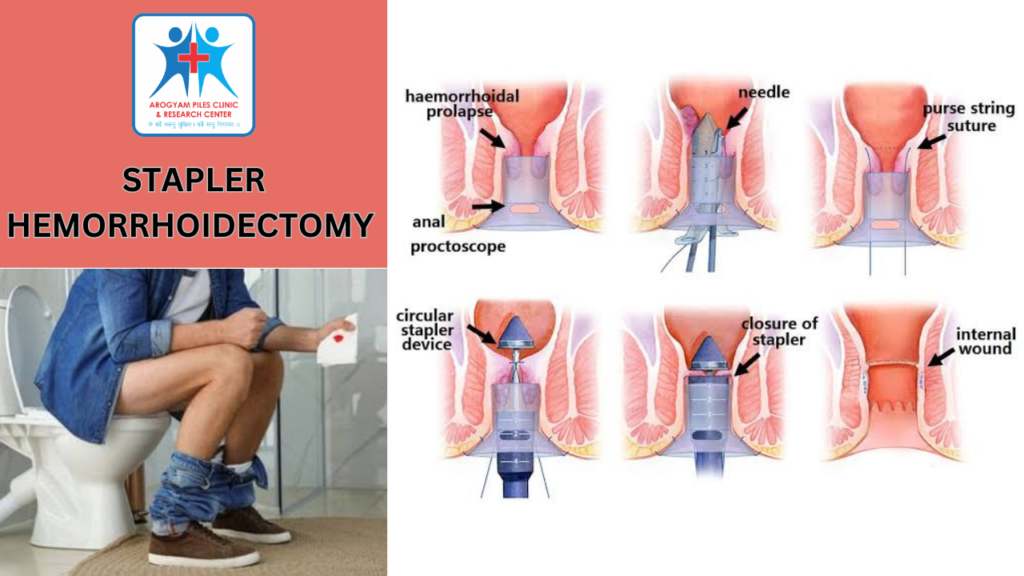
Hemorrhoids, also known as piles, are swollen veins in the rectal area that can cause discomfort, pain, and bleeding. While conservative treatments such as dietary changes, topical creams, and sitz baths can provide relief for mild cases, severe or persistent hemorrhoids may require surgical intervention. One of the surgical options available is a stapled hemorrhoidectomy. In this article, we will explore the procedure, benefits, and drawbacks of stapled hemorrhoidectomy.
What is Stapled Hemorrhoidectomy?
Stapled hemorrhoidectomy, also known as procedure for prolapse and hemorrhoids (PPH), is a surgical technique used to treat internal hemorrhoids. Unlike traditional hemorrhoidectomy, which involves excision of the hemorrhoidal tissue, stapled hemorrhoidectomy uses a circular stapling device to remove excess tissue and restore the normal anatomical position of the hemorrhoids.
The Procedure:
- Anesthesia: The procedure is performed under general anesthesia or regional anesthesia, depending on the patient’s preference and the surgeon’s recommendation.
- Positioning: The patient is placed in the lithotomy position, lying on their back with legs raised and supported in stirrups.
- Insertion of the Stapler: A specialized circular stapling device is inserted into the anal canal. The stapler is equipped with a circular stapler head and a circular anal dilator.
- Lifting and Excision: The surgeon grasps the prolapsed hemorrhoidal tissue using a surgical instrument and lifts it into the stapler head. The excess tissue is then removed by excising a circular section above the dentate line.
- Stapling and Closure: The stapler is activated, creating a circular staple line above the hemorrhoids. Simultaneously, the stapler cuts and seals the tissue, leading to repositioning of the hemorrhoids back into their normal position. The stapled line effectively reduces the blood flow to the hemorrhoids, promoting healing.
- Closure of the Wound: Any remaining wounds or mucosal defects are closed using absorbable sutures.
- Post-Procedure Care: After the procedure, the patient is monitored for a short period in the recovery room before being discharged. Pain medication, stool softeners, and dietary instructions are provided to ensure a smooth recovery.
Benefits of Stapled Hemorrhoidectomy:
- Reduced Postoperative Pain: Stapled hemorrhoidectomy generally causes less postoperative pain compared to traditional hemorrhoidectomy. The stapling technique avoids extensive tissue excision and results in fewer nerve endings being exposed, leading to reduced discomfort for the patient.
- Shorter Recovery Time: Patients who undergo stapled hemorrhoidectomy often experience a faster recovery compared to traditional surgery. The procedure is associated with less tissue trauma and minimal external wounds, allowing patients to resume their daily activities sooner.
- Lower Risk of Anal Stenosis: Anal stenosis, a condition characterized by the narrowing of the anal canal, is less likely to occur with stapled hemorrhoidectomy. The preservation of tissue and blood flow helps maintain the natural anatomy of the anal canal.
- Reduced Bleeding: Stapling the hemorrhoidal tissue simultaneously cuts and seals the blood vessels, minimizing intraoperative and postoperative bleeding.
Drawbacks of Stapled Hemorrhoidectomy:
- Higher Cost: Stapled hemorrhoidectomy may be more expensive than traditional hemorrhoidectomy due to the specialized equipment and expertise required.
- Risk of Recurrence: While stapled hemorrhoidectomy is an effective treatment, there is a small risk of recurrence. In some cases, additional procedures or alternative treatments may be required.
- Potential Complications: As with any surgical procedure, there are potential risks and complications associated with stapled hemorrhoidectomy. These can include infection, bleeding, anal fissures, urinary retention, and rarely, rectal perforation.
- Limited Applicability: Stapled hemorrhoidectomy is most suitable for internal hemorrhoids and may not be appropriate for all patients or certain types of hemorrhoids. The surgeon will assess each case individually and determine the most suitable treatment option.
Conclusion:
Stapled hemorrhoidectomy is a surgical procedure that offers several benefits compared to traditional hemorrhoidectomy. It is associated with reduced postoperative pain, shorter recovery time, and a lower risk of anal stenosis. However, it is important to consider the potential drawbacks and risks associated with the procedure. Patients should consult with a qualified healthcare professional to determine the most appropriate treatment option based on their specific condition and medical history. If you are looking for expert advice about you Piles, you can consult with piles doctor at Arogyam Piles Clinic and Research Center, located in Mohali, Chandigarh. To book an appointment you can visit there official website www.arogyampilesclinic.com or directly call +91 96467 64444.
Remember, this blog post is for informational purposes only and should not be considered medical advice. If you are experiencing hemorrhoid symptoms, consult with a healthcare professional for an accurate diagnosis and appropriate treatment plan.



